Determination and Validation of a Single Laboratory Method for Coenzyme Q10 (Ubiquinone) by UHPLC
LCGC North America
A fast ultrahigh-pressure liquid chromatography (UHPLC) method, with low solvent consumption, is described for the determination of coenzyme Q10 in a variety of complex formulations. This method exhibits good linearity, reproducibility, accuracy, recovery, and specificity, while resulting in an acceptable limit of detection (LOD) and limit of quantification (LOQ).
A single laboratory validation study (SLV) was performed using an ultrahigh-pressure liquid chromatography (UHPLC) for the determination of coenzyme Q10 in a variety of formulations (raw materials, soft gel capsules, and in-process blend). The authors first developed an efficient extraction procedure to obtain coenzyme Q10 from finished products, and then used UHPLC to analyze the ingredient. Compared to the traditional high-performance liquid chromatography (HPLC) method, the UHPLC method reduced the total run time from 15 min to less than 2 min. The total amount of solvent usage was also reduced by 90%, which is a big contribution to green chemistry. The established UHPLC method exhibits good linearity, reproducibility, accuracy, recovery, and specificity. The limit of detection (LOD) and limit of quantification (LOQ) were also captured in the study, and have been proven suitable for monitoring the coenzyme Q10 in complex matrices.
Coenzyme Q10 (Co Q10) is a nutrient that the body produces naturally for cell growth and maintenance. Research have shown that Co Q10 can lower blood pressure slightly (1). Co Q10 is also used to treat heart failure and other heart conditions (2). It acts as an antioxidant that protects cells from the effects of aging, and it is found inside the mitochondria of most cells; it is also believed that Co Q10 improves the tolerability of cancer treatment, and reduces liver toxicity (3). In addition, Co Q10 is used in prevention and treatment of cardiovascular disease, particularly hypertension, hyperlipidemia, coronary artery disease, and heart failure (4). Other research has reported that Co Q10 helps support the production of cellular energy (5–7). In nature, Co Q10 is found in meat, fish, and whole grain. However, the amount of Co Q10 found in these dietary sources is not high enough to significantly increase the Co Q10 levels in the body. Therefore, it is considered beneficial to take Co Q10 as a dietary supplement.
Co Q10 can exist in three oxidation states: the fully reduced ubiquinol form, the radical semiquinone intermediate form, and the fully oxidized ubiquinone form (8). The structures of each form are shown in Figure 1. Unlike conventional Co Q10, ubiquinol is a very powerful antioxidant by virtue of its two extra electrons. Those electrons are important because they hold the key to neutralizing free radicals (9). Therefore, ubiquinol is a preferred supplement and is used in our products.
Figure 1: The molecular structures of different redox forms of coenzyme Q10.
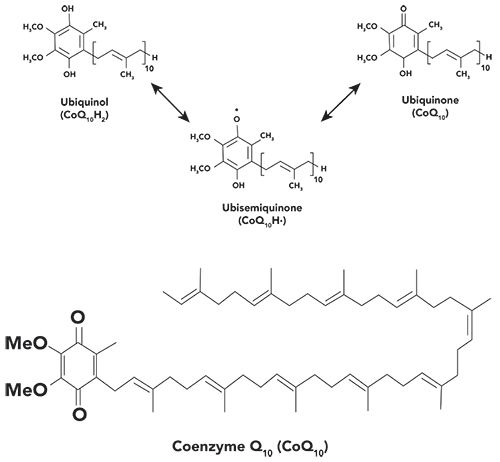
Ultrahigh-pressure liquid chromatography (UHPLC) is a modern technique that has advanced liquid chromatography (10–17). In 2004, separation science was revolutionized with the introduction of UHPLC. Significant advances in instrumentation and column technology were made to achieve dramatic increases in resolution, speed, and sensitivity in liquid chromatography. For the first time, a holistic approach involving simultaneous innovation in practice, technology, and instrument design came together to meet and overcome challenges in the analytical laboratory.
Method validation is the process used to confirm that an analytical procedure employed for a specific test is suitable for its intended use. Results from method validation can be used to judge the quality, reliability, and consistency of analytical results. Therefore, it is an integral part of good analytical practice. The U.S. Food and Drug Administration (FDA), the International Council for Harmonisation of Technical Requirements for Pharmaceuticals for Human Use (ICH), the Environmental Protection Agency (EPA), and other regulatory agencies and industrial committees have clear guidelines on how and when to validate and revalidate a method (18–23).
In the work presented here, the authors have developed a UHPLC method for quantitatively analyzing Co Q10 raw materials and finished products. This UHPLC method has been validated to prove that it is suitable for its intended use regardless of the matrix. An efficient extraction method was developed to extract Co Q10 from various complex matrices.
Validation was performed according to USP chapter <1225>, Validation of Compendial Procedures. Specific calculations were used for accuracy, precision, linearity, limit of detection (LOD), and limit of quantification (LOQ) through various Excel functions.
Materials and Methods
Materials
Coenzyme Q10 reference standard (Cat# 1705301) was purchased from USP. The coenzyme Q10 200 mg USP sample (A640, lot# 2253063) and coenzyme Q10 raw material (394403, lot# 1704102-1) were from Pharmavite LLC. Reagent alcohol (HPLC Grade), acetonitrile (HPLC grade), and hexanes (HPLC grade) were purchased from EMD Millipore Corporation.
A Kinetex C18, 2.1 mm X 50 mm, 2.6-µm column (Cat # 00B-4462-AN) was purchased from Phenomenex, Inc. The mobile phase is a mixture of 30% acetonitrile and 70% reagent alcohol. The mobile phase flow rate was 0.5 mL/min. Total run time was 2 min.
All solvents were filtered before use through a 0.45 µm GMF filter from GE Healthcare Whatman.
Instruments
A Waters Acquity UHPLC system with a PDA or TUV detector was used. The UHPLC system was operated using Waters Empower 3 software for data acquisition and storage.
Sample Preparation
The coenzyme Q10 standard was dissolved in hexane (25% of the flask volume) by shaking with a wrist shaker. The sample was further diluted with reagent alcohol to a final concentration of the standard and sample of 0.04 mg/mL. Sample and standard were then filtered through a 0.45 µm GMF filter before injection into the UHPLC instrument. The sample preparation method for raw materials, in-process blends, and soft gel capsules were the same as for the standard.
Results and Discussion
Specificity
The column efficiency for coenzyme Q10 was >2000 theoretical plates. The USP tailing factor was ≤1.2.
The following samples were injected: blank, placebo, standard, and sample. Retention time of the Co Q10 was 0.62 min in the chromatogram, which corresponds to those in the chromatogram of the standard solution, and no interfering peaks were present at the retention time of the active peak in the blank and placebo (Figure 2).
Figure 2: UHPLC chromatograms of (a) standard, (b) sample, (c) blank, and (d) placebo.
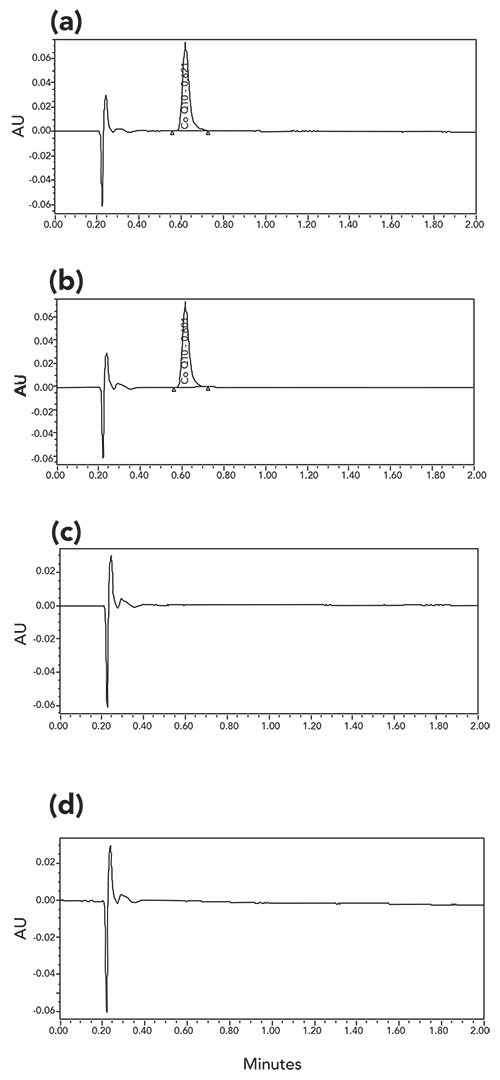
Linearity
The linear dynamic range established covers a concentration of the standard from 0.02 mg/mL to 0.08 mg/mL, which is 50% to 200% of the sample concentration used in the analyses. The linearity data is presented in Table I and Figure 3. The R2 is not less than 0.9995. The calibration curve was constructed by the plotting peak area of the standard versus concentration (50%, 75%, 100%, 150%, and 200%).
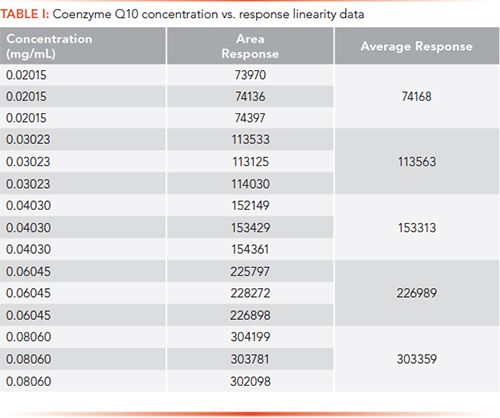
Figure 3: Coenzyme Q10 concentration vs. response linearity plot (R2 = 0.999758).
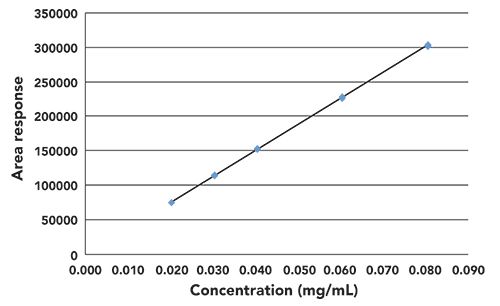
Limit of Detection
Detection limit was shown to be sufficiently low, with known concentration above and below the required detection level. The lowest concentration for coenzyme Q10 was 0.0005 mg/mL.
Limit of Quantitation
The quantitation limit was shown to be sufficiently low, with known concentration above and below the required detection level. The limit was determined by injecting 10 different concentrations of the standard. The lowest concentration by this method was 0.004 mg/mL (Table II, Figure 4), which is within the linearity range of this testing method.
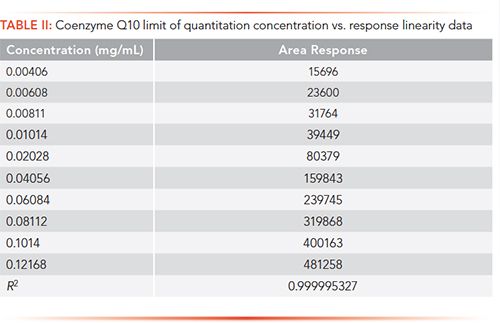
Figure 4: Coenzyme Q10 limit of quantitation (LOQ) concentration vs. response linearity plot (R2 = 0.9999953)
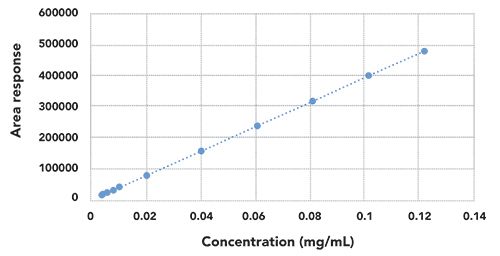
Precision
Precision was determined by analyzing six separate samples prepared from a homogeneous sample matrix under the prescribed conditions. The results are presented in Table III for raw materials, and Table IV for finished products. The percent relative standard deviation (% RSD) of six replicate injections for four sets of precision results were from 0.63% to 2.30%, which were well within the acceptance criteria for precision of <3% RSD.
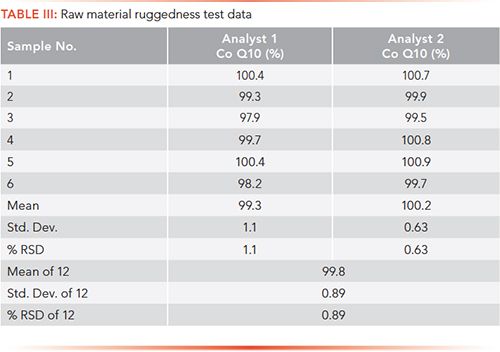
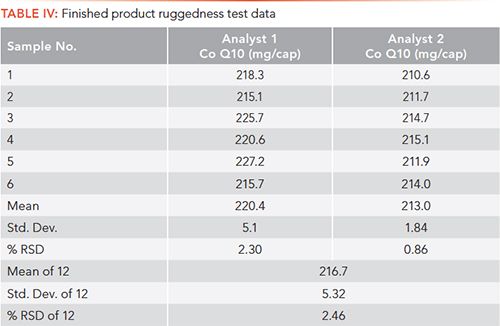
Accuracy
The accuracy study was performed with nine samples containing three concentration levels (50%, 100%, and 150%). A placebo containing all excipients in the dosage form except for Co Q10 was spiked with freshly prepared concentration levels, according to the sample preparation procedure. The placebo sample was also analyzed to ensure that there was no interference (Table V). The average recovery of Co Q10 from the sample matrix was 99.2%–101.5%, which is within the acceptable range of 90 to 110%.
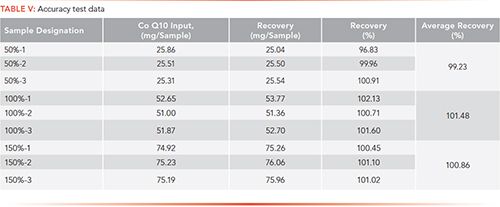
Ruggedness
A ruggedness study is a good indication of analytical method’s robustness. It is the ability of the method to remain unaffected by small variations in method parameters (such as, but not limited to, mobile phase composition, column age, column temperature, and the instrument used) and environmental factors (such as room temperature and air humidity), or the performance of any individual analyst. Table III and Table IV present the raw material and finished product precision data that were generated by different chemists on different days in different laboratories. The samples used were from the same lot of the materials. The % RSD for each 12 sets of data was 0.89% for raw material, and 2.46% for finished product. Our results showed that this analytical method is very reproducible from laboratory to laboratory, and from chemist to chemist.

Stability
In this study, a stock standard solution was prepared and kept at 4 °C. To mimic the real working conditions, the stock standard solution was taken out of the refrigerator and allowed to come to room temperature every day, and the cap was opened for 2 min to take out stock standard to prepare the working standard, even if the standard was not tested on that day. On days 1, 3, 7, and 14, the standard was injected in the UHPLC instrument, and peak retention time and peak area were compared to their initial values (Table VI). The Co Q10 stock standard at day 14 showed 98.9% of peak area compared to the initial analysis, which is <3% of acceptance criteria of the stability study.

Forced Degradation Studies
A stressed degradation study was conducted on the coenzyme Q10 sample with the following conditions: 1 N HCl was added and the solution was heated for 1 h at 60 °C; the 1 N NaOH was added and the solution was heated for 1 h at 60 °C; then 30% H2O2 was added and the solution was left for 1 h at room temperature; the sample was placed under the light for 8 d (Table VII). The effect on peak area, as percent of initial area, was measured and reported for these various degrading conditions.
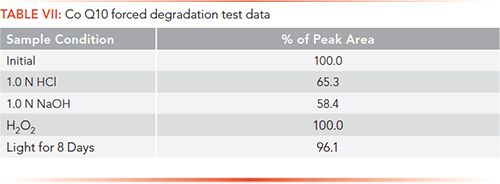
Conclusion
In this paper, a fast UHPLC method was developed for Co Q10 analysis in raw materials and finished products. This method was shown to be accurate, precise, specific, and with a wide linear range. Compared to a traditional HPLC method, the UHPLC method is a faster and more efficient way to analyze the compound of interest. The UHPLC method also reduces more solvent consumption, which is more environmentally friendly.
Acknowledgments
The authors acknowledge the Analytical Services, Quality Control, and R&D departments at Pharmavite LLC for their support in this research work.
References
- A. Soja, Mol. Aspects Med. 18(Suppl), S159–S168 (1997).
- R. Saini, J. Pharm. Bioallied Sci.3(3), 466–467 (2011).
- L. Roffe, K. Schmidt, and E. Ernst, Journal of Chemical Oncology 22(21), 4418–4424. (2004).
- B. Sarter, Journal of Cardiovascular Nursing16(4), 9–20 (2002).
- M. Battino, M. Ferreiro, S. Bomparde, L Leone, F. Mosca, and P. Bullon, J. Periodontol.72, 1760–1766 (2001).
- M. Battino, P. Bullon, M. Wilson, and N. Newman, Crit. Rev. Oral Biol. Med. 10, 458–476 (1999).
- R. Saini S. Saini, and S. Sharma, Int. J. Green Pharm. 3, 212 (2010).
- J. Higdon, V. Drake, B. Delage, and R. Stocker, Linus Pauling Institute Micronutrients Information Center, Oregon State University (2003–2018).
- B. Frei, M.C. Kim, and B.N. Ames, Proc. Natl. Acad. Sci. USA 87(12), 4879–4883 (1990).
- J.J. Van Deemter, E.J., Zuiderweg, and A. Klinkenberg, Chem. Eng. Sci. 5, 271–289 (1956).
- B. Srivastava, B.K, Sharma, U.S. Baghel, and S.N. Yashwant, International Journal of Pharmaceutical Quality Assurance2, 19–25 (2010).
- J. Zhu, J, D.M. Goodall, and S.A.C. Wren, LCGC North Am. 23(1), 54–72 (2005).
- F. Gerber, M. Krummen, H. Potgeter, A. Roth, C. Siffrin, and C. Spoendlin, J. Chromatogr. A1036,127–133 (2004).
- D.T. Nguyen, D. Guillarme, S. Rudaz, and J.L. Veuthey, J. Sep. Sci. 29, 1836–1848 (2006).
- K.M. Grinias, J.M. Grodino, E.G. Franklin, J.T. Stobaugh, and J.W. Jorgenson, J. Chromatogr. 1469, 60–67 (2016).
- J.W. Eschelbach, and J.W. Jorgenson, Anal. Chem.78, 1697–1706 (2016).
- I. Tolley, J.W. Jogenson, and M.A. Moseley, Anal. Chem.73, 2985-2991 (2001).
- U.S. Department of Health and Human Services, Food and Drug Administration., Guidance for Industry, Bioanalytical Method Validation (2001).
- G.C. Hokanson, Pharm. Tech.18(10), 92–100 (1994).
- J.M. Green, Anal. Chem. 68(9), 305A–309A (1996).
- B. Renger, H. Jehle, M. Fischer, and W. Funk, J. Planar Chrom.8, 269–278 (1995).
- I. Taverniers, M. De Loose, and E. Van Bockstaele, Trends in Anal. Chem.23(8), 535–552 (2004).
- S. Seno, S. Ohtake, and H. Kohno, Accred. Qual. Assur. 2, 140–145 (1997).
Louisa Manasyan is an analytical scientist in the Analytical Services Department of Pharmavite LLC, in San Fernando, California. Fang Xia is a manager in the Analytical Services Department of Pharmavite LLC, in Valencia, California. Mohamed Koroma is the director of Analytical Services at Pharmavite LLC, in Valencia, California. Thomas Hines is the director of Quality Control at Pharmavite LLC, in West Hills, California. Martin Dennison is the VP of Quality at Pharmavite LLC, in West Hills, California. Direct correspondence to: lmanasyan@pharmavite.net
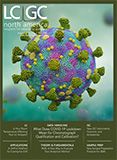
Separating Impurities from Oligonucleotides Using Supercritical Fluid Chromatography
February 21st 2025Supercritical fluid chromatography (SFC) has been optimized for the analysis of 5-, 10-, 15-, and 18-mer oligonucleotides (ONs) and evaluated for its effectiveness in separating impurities from ONs.

.png&w=3840&q=75)

.png&w=3840&q=75)



.png&w=3840&q=75)



.png&w=3840&q=75)









